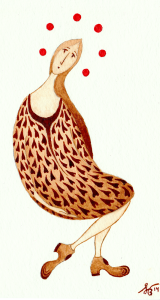
On paper, Samu Boyne (SFS ’18) seems like your typical Georgetown student: He ismajoring in regional comparative studies and is originally from Dallas, Texas. However Boyne is an accomplished painter with a special interest in Japanese culture and the ability to make delicate artwork using coffee as paint. The Hoya sat down with Boyne this week to discuss his art and its influences.
Your work seems to take a lot of pointers from Japanese and Asian art. Tell me about your artwork and its cultural influences. How did the Japanese influence come about?
I guess probably since my childhood, I moved around a lot, but one of the things I always had was video games, specifically Japanese video games.
So those different stories in the games … and Japanese video games tend to be much more creative than American video games. I could go on a rant about that. But throughout my life, I’ve been affected by the “soft power,” you could say, of Japanese culture.
[He shows a colorful watercolor drawing of a Japanese woman in a coat and dress.]
This is influenced by Japanese fashion subculture. I often do character designs.
How do you manage to get the minute details?
Just with small brushes. I did this last year in my dorm. I haven’t been able to do much art while I’ve been here besides my Uncommon Grounds series. It was a small series on “Femininity and Diversity.” I wanted to do something that reflected the diversity of Georgetown, especially for female figures in this case. It’s obviously very imagination-based, because it’s not very realistic at all, and when I draw it’s pretty much all from imagination. I never look at pictures.
For a composition like this, how long would that take you?
I tend to do things in one sitting. This [coffee] series took a long time as I did them all at the same time instead of one. But something like this colorful one, I think I did it in around eight hours. [Boyne shows a composition with the silhouette of mountains drawn onto a man’s body]. I went to China this past summer, and there were all these beautiful mountains …[he points to red stamp at the bottom]. This is a Chinese/Japanese style signature so it has my Japanese name carved into it.
Is there anyone in particular that inspires you in the art world?
My top inspiration figure would be Hayao Miyasaki. He’s a director of one of Japan’s biggest and most famous animation studios. You might have heard of “My Neighbor Totoro” or “Spirited Away.” Definitely from the imagination aspect, as well as the stylization, artistic aspect.
If someone were to say to you that he or she was taking an art class here at Georgetown next semester, what would you say is an important thing to keep in mind when doing a composition?
I’ve never actually taken an art class here. But that’s because of my rebellion, right? I have considered it. Obviously you have to fulfill the set standards for a project, but I would definitely say to not be afraid to put your own work into it.
When I was in high school, one of my teachers wanted me to do a still life and I despise still life. So I started to do different, more geometric shading, which gives it a more surreal aspect.
Do you think that your art in particular is a good reflection of you as a person, and your personality?
Absolutely, especially with my more recent work. One thing I always have done, is write out stories behind my art. This one has a haiku that goes with it. And this one has a hidden message, it’s sort of about the act of giving and receiving– the words that imply that in Japanese are very similar sounding, so it’s wordplay within art.
You seem to be into fashion and I know you do some work for Thirty Seventh GU, how would you describe your personal style?
I’m actually one of the co-editors. I’m definitely very interested in fashion, especially Japanese fashion. Specifically in Japan, there’s a district called Harajuku, which is known for its craziness. Some people will twist it around and say “it’s so weird,” but in actuality it’s just creative people who express that through clothes. That’s sort of what I try to do. In recent times, I try to dress in ways that hopefully make people happy.
Do you think that Georgetown is a good place to be a student interested in art? Are there any museums or current exhibitions that you would recommend around here or in D.C.?
Well definitely D.C. is a great place because we have a bunch of free museums and exhibits.
One of my favorite museums is the East Asian Freer and Sackler Galleries. They have ancient stuff but then they have more modern Asian-influenced art, which is what I specialize in.
But Georgetown itself may not be the greatest; I’ve never actually met an art major that is only doing an art major — it’s not common. When I was applying to Georgetown, I did an alumni interview and my interviewer basically said, “If you like art, don’t go to Georgetown.” I was sort of taken aback by that as at the time I was deciding between Georgetown and Rhode Island School of Design and they were two very different paths for me. But I think you can make it your own, and I think Georgetown’s a good place where you can learn from your experiences and put it into your art.
Boyne’s work, shown here, has been exhibited by the Georgetown University Arts Association and can currently be seen in Uncommon Grounds until January 2016.



















